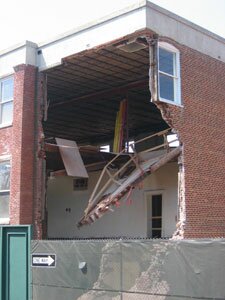ON ARCHITECTURE- Façade and effect: Courthouse collapse raises questions
It's been more than five months since the northeast corner of the old Juvenile and Domestic Relations courthouse on High Street collapsed, threatening to derail the $15 million City-County venture that has been discussed since the mid-'90s.
On March 30, workers for Kenbridge Construction were in the process of "underpinning," or reinforcing, the foundation with a converted track hoe when they noticed a crack forming on the back wall. Fortunately, they quickly evacuated the area, and no one was hurt when the corner sheared away and fell into a dusty pile of old bricks.
Now it looks like that dusty pile of bricks may rise from the rubble.
In 2004, Charlottesville and Albemarle County officials approved what they described as long-overdue renovations, which include three new stories, a three-level, 91-space parking deck, and renovations to the old Albemarle County Jail and the Levy Opera House. But the structural mishap stopped the project in its tracks. Scaffolding was erected to stabilize the corner of the 110-year old building, and all construction ceased while a $100,000 engineering study was conducted to determine the cause of the collapse and the cost of repair versus demolition.
According to city attorney Craig Brown, the engineering study by Manassas-based engineering firm Whitlock Dalrymple Poston & Associates concluded that demolishing the building would cost "three times as much" as stabilizing and repairing the corner.
As for the cause, Brown says he's not ready to release that information until Kenbridge Construction has had a chance to respond to the findings.
"If there's a disagreement with the contractor over the cause," says Brown, "it could go to litigation, although I'm not anticipating that happening."
Brown says the project has been sent back to the architects, Mosley & Associates, which will perform additional design work and issue a plan for restoring the corner. Reconfiguring the corner out of a pile of old bricks could be complicated, time consuming, and expensive, but Brown can't say just how expensive until the architect and the contractor work out a solution.
In the meantime, the courthouse remains just as it was on the day of the collapse, raising questions about the potential cost, the wisdom of "façadism" in the preservation of historic buildings, and whether reassembling a pile of old bricks is really historic preservation at all.
The Colonial Revival building was constructed in 1902 as Elks Lodge No. 389 and housed a library and a billiard parlor– and even a bowling alley. A big four-column portico originally graced the front with a giant moose head under its peak. But after a fire destroyed much of the building in 1940, local architect Floyd Johnson decided not to rebuild it. Other interesting details include two pilasters mimicking Doric columns, and a rusticated façade on which every fifth brick is indented.
However, as Marc Wagner of the Virginia Department of Historic Resources told the Hook in March, the courthouse wasn't the only historic gem on the site. "The courthouse is interesting," he said, "but the jail is really unusual." The old Albemarle County Jail beside the courthouse looks like something out of the Middle Ages with its huge block stone walls and thin, barred windows. It was there that Charlottesville mayor Sam McCue (the subject of the Hook's October 30, 2003 cover story) was hanged in 1905 for murdering his wife in their Park Street home. The structure was still being used to hold prisoners as late as the 1970s.
While it appears the old courthouse is going to be repaired, the collapse could have an effect on other façade-saving renovation projects such as developer Keith Woodard's nine-story First & Main project on the Downtown Mall. Woodard has proposed demolishing everything but the facades of the buildings he owns at and between 100 and 111 East Main, a plan the Board of Architectural Review rejected in May. Woodard appealed the decision to City Council, and his demo plans for First & Main are currently on hold while various committees study the project.
In June, before Woodard's appeal, a group called Preservation Piedmont sent a letter to City Council regarding his demolition plans, warning Council of the structural risks and consequences of "façadism" and using the collapse of the courthouse as an example.
Preservationists believe that attempting to restore buildings by saving only the facades is practically asking them to fall. Indeed, after the collapse, UVA structural engineering professor Tom Baber questioned the integrity of the courthouse's brick wall. "If you notice," he said, "the bricks just crumbled into a big pile, instead of sheets of wall, which means the mortar was probably bad."
Despite the recent decision to repair the collapsed building, as far as Preservation Piedmont is concerned, it has already been lost.
"A new building fashioned out of scavenged rubble is not a historic structure," the group wrote. "It is a loss against which no insurance policy can protect."
The letter also criticized the spirit of Woodard's façadist demolition plans– and by extension the courthouse project– calling such efforts "tokenism" that lacks "both the authenticity of an old building and the potential originality of a new one."
"It's a crap-shoot when you try to save a façade," says Aaron Wunche, an officer with Preservation Piedmont, "and I think this [the courthouse collapse] will have direct implications for the Woodard project."

March 30: the day of the collapse. PHOTO BY DAVE MCNAIR

September 4: little has changed but the scaffolding. PHOTO BY DAVE MCNAIR
#